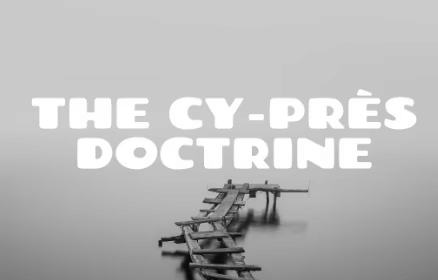The Code of Civil Procedure | Civil Law for Judiciary Exams PDF Download
Doctrine of Cy pres
The term cy pres originates from the Norman French phrase "cy pres comme possible," meaning "as near as possible." The doctrine of cy pres enables courts to modify or reinterpret the terms of a charitable trust when it becomes impossible or impractical to fulfill the trust's original intent.

Doctrine of Cy Pres under the Civil Procedure Code (CPC)
Section 92(3) of the Civil Procedure Code outlines the circumstances under which a court may alter the purposes of a charitable or religious trust. Under this provision, courts can redirect the property or income of such trusts to purposes that align as closely as possible with the trust's original intent. This ensures the trust’s spirit is preserved, even if the original objectives cannot be wholly or partially achieved due to reasons such as:
- Fulfillment of the original purpose by other means.
- The purpose becoming obsolete, harmful, or no longer charitable.
- Legal, practical, or geographic constraints rendering the original purpose unattainable.
By invoking the cy pres doctrine, courts maintain the trust's overall charitable or religious intent while adapting its implementation to changing circumstances.
Section 92(3) of the CPC
Under this section, courts may modify a trust's purposes and apply the property or income cy pres in the following scenarios:
Fulfillment or Impossibility:
- The original purpose has been achieved as far as possible.
- The purpose cannot be implemented at all or in accordance with the trust's terms or spirit.
Partial Application:
- The original purposes apply to only a portion of the available property.
Combined Use:
- The trust property, alongside similar properties, can be more effectively applied to a different, yet related, purpose.
Geographical Changes:
- The original purpose references a region that has ceased to function as a relevant unit for that purpose.
Inadequacy or Obsolescence:
- The original purpose has been met by other means.
- It is no longer useful, charitable, or beneficial to the community.
- It is unsuitable or ineffective for using the available property.
In all cases, courts ensure the revised application aligns as closely as possible with the trust’s original intent and spirit.
Landmark Judgments on the Doctrine of Cy Pres
Ratilal v. State of Bombay (1954):
- The Supreme Court addressed the application of the cy pres doctrine in this case, ensuring the objectives of charitable trusts were preserved despite restrictions under the Bombay Public Trusts Act, 1950. The Court emphasized that when a charitable trust's specific purpose fails or becomes impractical, courts may redirect its funds towards a similar charitable goal aligned with the trust's general intent.
N.S. Rajabathar Mudaliar v. M.S. Vadivelu Mudaliar & Ors. (1970):
- Here, the Supreme Court applied the cy pres doctrine to redirect trust funds when the original purposes became unattainable.
Abid Hatim Merchant v. Janab Salebhai Saheb Shaifuddin & Ors. (2000):
The Supreme Court, referencing Halsbury's Laws of England, highlighted key principles of the cy pres doctrine:
- Courts administer charitable trusts to align with the donor's general charitable intent, even if the specific mode of application fails.
- The donor’s intentions must be followed as closely as possible, favoring objects and methods nearest to their original wishes.
- In cases where no close alternative exists, the property may still be redirected to charitable uses consistent with the trust's overarching purpose.
Doctrine of Dominus Litus
- The Doctrine of Dominus Litus, meaning "Master of the Lawsuit," determines who controls a legal case.
- This doctrine allows the plaintiff to choose who is involved in the lawsuit, but this right is not absolute.
- According to the Code of Civil Procedure, 1908 (CPC), specifically Order 1, Rule 10, the court can add or remove parties to ensure all necessary individuals are included.
- The court evaluates the involvement of added parties and can accept or reject their claims based on the situation; there is no automatic right to be included.

Purpose of the Doctrine of Dominus Litus
- The term "Dominus Litus" refers to the person who has a real interest in the outcome of a lawsuit.
- This individual can benefit from a positive judgment or face consequences from a negative one.
- Even if someone is not part of the original case, they can intervene and take control over one side, being treated as a responsible party by the court.
- The plaintiff (the Dominus Litus) cannot be forced to include parties they do not want, unless the law requires it.
- The court can add necessary parties for a complete resolution, even without a request from the plaintiff.
- The court's power to add parties is broad, as outlined in Order 1, Rule 10(2) CPC.
Applicability and Non-Applicability of the Doctrine
Applicable Situations:
- The court can include a party as a defendant under Section 92 of the CPC in any lawsuit.
- In specific performance suits (for sale contracts), the plaintiff is Dominus Litus and cannot be forced to involve unwanted parties, unless required by law.
Non-Applicable Situations:
- In partition suits, the strict application of this doctrine does not apply since all parties are co-sharers.
- In the case of execution petitions, the rules about party addition under Order 1 Rule 10 do not apply.
- The doctrine is limited to specific causes of action as clarified by the Supreme Court in the case of Mohannakumaran Nair v. Vijayakumaran Nair (2008).
Conclusion
- The plaintiff is usually seen as the Dominus Litus because they are seeking compensation or justice for a wrong done to them.
- According to Order 1 Rule 10(2) of the CPC, the court has discretion in granting relief and considers the plaintiff's choices when adding third parties.
- However, if necessary for resolving the dispute, the court can add a defendant even if the plaintiff disagrees.
- This principle ensures that those initiating legal action play a key role in how the case progresses, promoting fair and efficient dispute resolution.
|
363 docs|256 tests
|
















